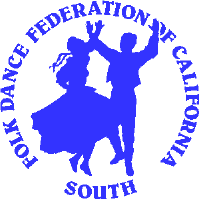
|
Folk Dance Federation of California, South, Inc.
|

|
CLICK IMAGE TO ENLARGE
Dance scholars, just as many other scholar types, seem to try for job security by eternally seeking to describe their discipline and never being satisfied.
Try describing "dance" and the problem will bcome obvious as you try to be all-inclusive, as any description must be, without including someting that isn't dance. If dance is defined as "expressive movement," you include a threatening raised hand; if you try "movement to rhythm," you eliminate some of the Macedonian dances in which the musicians follow the lead dancer and there is no rhythm. Music is not always necessary, as many forms of both folk and theatrical dance do very well without it.
The most commonly accepted definition of dance is "movement for its on sake," but that would appear to include simple walking just to be walking. Perhaps we should amend: "extraordinary movement for its own sake" — i.e., outside the normal movements of life.
Moving on, there are different ideas about what constitutes "folk" and "ethnic" dance, much of it adopted to further a political agenda. Its fallacy is in being unable to stand up to its own definition.
"Etnnic" does not mean "non-white."
"Folk" does not mean "rural."
"Ethnic dance" is any dance form which can be identified as originating with an ethnic culture and expressing the movement aesthetics of that culture. It includes all ethnic cultures, whether European, American, African, Polynesian, Asian, Middle Eastern — all of them. It includes village folk dance, urban popular dance (swing, tango), classic dance (Kathak, Bharat Nayam), tribal dance, tap dance, and many more, It does not include the classic theatrical forms of balley, jazz, and modern dance, but notice that there are theatrical forms included. The primary criteria is simply identification with an ethnic culture of origin.
Ethnic dance includes several sub-categories: "folk," "theatrical," "religious," "tribal," "social," and so on. Our major interest is with the first two, bur we'll take a quick look at the others.
"Folk" dance requires not only an ethnic identification, but a "participatory" and aesthetic tradition. It is dance that is an integral part of the culture, thus the traditional village dances of Europe, the Hawaiian hula, the American clog, the Mexican Hat Dance, and the Argentine tango are "folk" dances. A strong case can also be made for including American Swing.
"Theatrical" forms of ethnic dance are well-known, primarily in Asia, where professional dancers perform dances that are prescribed by tradition. The dances are found in India, Japan, and throughout Southeast Asia, and are highly developed with extraordinary costume, makeup, props, and sets, usually telling an ancient fable for the entertainment of select audiences.
"Tribal" dance generally origintes in a "pre-industrial" culture, created in a subsistence environment, and functioning as an integral part of life. The tribal dance is communication with the supernatural, a rite of passage, a courage builder for battle, a celebration victory, or a mourning ritual in defeat. It is serious and rarely performed as recreation.
Ballet, jazz, and other forms of theatrical dance fall outside the umbrella of "ethnic" dance, becuse they are cross-cultural and have lost any ethnic identity they may have had. They do not express any ethnic identity or aesthetic, nor is that their intent; rather the focus is ever-more difficult and fantastic technical performance.
So, the next time someone refers to "ethnic" dance, question them. Make them a little uncomfortable by asking why they don't include the Ukrainian hopak (that's one they're probably familiar with), or the Hungarian csárdás, or the Argentine tango. How do they make the distinction between "ethnic" and "non-ethnic" dance. Make 'em squirm. A Dane, or Greek, or Hungarian, or Spaniard is as much of an "ethnic" as is a Hawaiian, an African, an Asian, or anyone else. The sooner we recognize that, the more equal we'll all be.
Used with permission of the author.